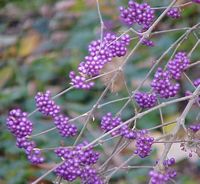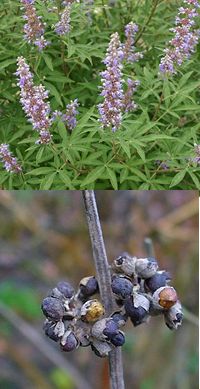Following our AGM at Reading University we are delighted to welcome three new members to our Group Committee; Dr David Atkinson of the University of Aberdeen and formerly East Malling; Dr Sebastian Eves-van den Akker of the University of Dundee and former winner of the David Miller Bursary Award and Prof Paul Hadley, Professor of Horticulture at the University of Reading. This trio will greatly strengthen our committee as it continues under the leadership of new chairman, Tony Girard.
On 25 November we will be joining the Professional Horticulture Group South West for their pre-Christmas lunch at Wiltshire College, Lackham where the guest speaker will be writer, lecturer and broadcaster Peter Thoday whose talk will be entitled, 'Compton Acres Revisited'.
Peter Grimbly
Contents
Strawberry and Honeysuckle
Plant of the Month
Medicinal Plant of the Month
News from our Associates
Horticulture Industry News
Events Calendar
Horticulture Group contact details
Related Links
Strawberry and Honeysuckle

The farm's location means that it is protected by the Isle of Wight giving it a particular microclimate suitable for early and long season production. Much of the crop is nevertheless grown under French polytunnels which give the crop extra protection from the elements and help with early cropping. They concentrate on early & late strawberries as these give the greatest return but also produce through the summer to keep staff & production going.
They have around 400 staff mainly recruited from Poland, Bulgaria and Romania. These are supervised by five managers. Four of these supervise growing, irrigation, harvesting and packing respectively while the fifth is responsible for staff health, welfare and accommodation. The majority of staff are paid on an hourly basis with bonus incentives. With 400 staff to pay the introduction of the Living Wage is a looming threat which is forcing them to look for varieties that are easier to pick and produce less waste. Sandy is also interested in some of the newer applications of robotics including developments like Google glasses which can tell pickers which fruit is ripe and thus remove ‘human error’.
They buy in young plants from Italy and Holland preferring potted plants as they find these are more predictable than un-rooted runner tips. These are planted in coir based growing bags, sixteen to a bag which is reused for up to three years.
They evaluate some fifty varieties each year in the search for better flavour, greater productivity and easier management. At the end of our visit we were invited to taste some of the newer varieties they were growing. Although there was a broad consensus the discussion highlighted once again the difference in people's taste preferences and the challenge the growers have to meet those varying demands through a long season.
On our way round we were introduced to a new crop, blue honeysuckle (picture lower middle). This is a shrub honeysuckle (as opposed to the more familiar climbers) that grows in the wetlands of the circumpolar boreal woodlands of Asia and America. It has been developed into a crop in Canada and Sandy is keen to diversify by growing it.
The fruit is tart and not really suitable as a fresh fruit however it makes excellent jams and chilli relish (picture lower right). His plan is to produce and market these end products with their added value and hopefully a greater return. His plants have now been growing for three years and he expects them to be in full production next year. Unfortunately they are liked by both birds and rabbits so they are in the process of erecting nets to protect the crop and ensure the majority of fruit goes into their jams and relish.
Plant of the Month
Callicarpa bodinieri var. giraldii ‘Profusion’, beauty berry, Verbenaceae

There are estimated to be 140 tropical and sub-tropical species in the genus including several cultivated ornamental shrubs. Callicarpa Americana originating in the southern parts of North America and the West Indies and C japonica are also grown in the UK, but this particular species hails from China. Indeed it is named for two European missionaries who collected plants in China. Emile Marie Bodinieri (1842-1901) was a French missionary mainly working in Guizhou province who made big plant collections and Giuseppe Giraldi (1848-1901) was an Italian missionary who collected plants from Shaanxi province from 1890 to 1895.
The fruits are very bitter, although not poisonous and thus dis-favoured by the birds tend to persist through much of the winter, enabling this plant to provide a long-lasting garden display.
Alison Foster
Plant of the Month
Vitex agnus-castus, chaste tree, monk’s pepper, Verbenaceae

Vitex is a genus of 250 tropical to temperate species with only one species growing in Europe, mainly in Mediterranean regions. However this species will also grow in the UK in full sun. It has also become naturalized in tropical regions.
Vitex agnus-castus is a deciduous shrub with palmate leaves – with each grey-green and hairy leaflet being quite narrow. The bilaterally symmetric flowers are blue/violet in colour and grow in a branching spike (picture right by Sten Porse).
The fruit (four-seeded berries - pictured right by H. Zell) can be used as a pepper substitute, although the common name of Monk’s pepper should indicate an element of caution with this as this common name comes from when medieval monks used to chew the fruits in a bid to curb their sexual desire.
In herbal medicine in Europe, the fruits or fruit extracts are used to treat a variety of menstrual disorders as well as menopausal problems.
Vitexilactone and rotundifurane are two such compounds that have been isolated from this species. These diterpenoids have been shown to have a dopaminergic action in the pituitary gland, resulting in the inhibition of prolactin secretion. Clinical studies provide evidence that the extracts work in the treatment of gynecological disorders such as premenstrual syndrome, dysmenorrhea and corpus luteum deficiency.
Amongst the other species of this genus Vitex rotundifolia is used medicinally, to treat ‘flu, colds and sore-eyes in modern Chinese herbalism.
Alison Foster
News from our Associates
Commercial Horticultural Association


The society has joined with the Association for Science Education, The Institute of Physics, The Royal Society of Chemistry and the Royal Society to produce a combined response to a Department for Education consultation on a Teachers' professional development standard

With the end of its initial three year funding the future of the Federation is under discussion as new sources of funding are sought. SCI Horticulture is keen to see the Federation survive and continue to gain strength. Our new Executive Director is also supportive and is in discussion with Mark Downs of the Royal Society of Biology to see how we might help.
Horticulture Industry News
For the very latest horticultural news follow us on Facebook,
Twitter, or
LinkedIn
Meet the Mighty, Mighty Moringa Tree
At first glance, gangly Moringa oleifera, with its thin stems and long seedpods, doesn’t look all that impressive. But ounce for ounce, the leaves contain three times the iron of spinach, four times the calcium of milk, and more protein than sardines. Farmed in its native India for centuries, M. oleifera is just now catching on in the United States. While the leaves can be prepared like spinach, they can also be dried and crushed into a powder that’s gaining popularity among smoothie-lovers. Moringa’s myriad applications go far beyond health shakes, however. Its roots have anti-inflammatory benefits; the seed cake (what’s left after oil extraction) can purify drinking water, fight bacteria, and act as fertilizer. In addition, growing M. oleifera combats erosion. More
Plant Could Hinder Malaria-Control Efforts
The invasive weed Parthenium hysterophorus, native to the American tropics, could hinder the fight against malaria in East Africa, where the plant is spreading fast. Researchers have found that P. hysterophorus can sustain the malaria-transmitting mosquito Anopheles gambiae even in the absence of a blood meal. In a small study the researchers found that the malaria vector A. gambiae was highly attracted to and fed frequently on P. hysterophorus. While the weed can be toxic to humans and livestock, the mosquito is able to ingest the plant’s poison without suffering negative effects. Researchers do not yet know why - possibly because mosquitoes are continuously being exposed to a wide range of chemical pesticides in the environment; they seem to be adapting to other toxins to ensure their survival! More
Gin in danger
Juniper could be in a 'critical state' due to the spread of the fungal disease Phytophthora austrocedrae. As well as an ingredient for gin producers, juniper provides food for some wildlife including the juniper shield bug. A report concludes that the decline of juniper is caused by the failure of juniper bushes - many of which are over a century old - to produce seeds. A survey found that 63% of bushes surveyed in Scotland were found to have brown patches, and 79% of juniper recorded in 2014 was either mature, old or dead. More
CRISPR Could Help Gene-Edited Crops Bypass Biosafety Regulation….
A twist on a revolutionary gene-editing technique may make it possible to modify plant genomes while sidestepping national biosafety regulations, South Korean researchers say. Plant scientists have been quick to experiment with the popular CRISPR/Cas9 technique, which uses an enzyme called Cas9, guided by two RNA strands, to precisely cut segments of DNA in a genome. By disabling specific genes in wheat and rice, for example, researchers hope to make disease-resistant strains of the crops. But the process can introduce bits of foreign DNA into plant genomes. And some jurisdictions, such as the European Union, could decide to classify such plants as genetically modified organisms (GMOs) — making their acceptance by regulatory bodies contentious, says geneticist Jin-Soo Kim of Seoul National University. By tweakimg the technique so that it can delete specific plant genes without introducing foreign DNA, scientists now think they might be able to produce plants that will be exempt from current GMO regulations. More
… The EU will decide
EU policymakers are about to embark on a process which will go a long way to shaping the future of plant breeding in Europe - and whether EU farmers will be able to benefit from an emerging new technology. After years of contemplation, the European Commission is expected to publish soon, possibly by the end of this month, its opinion on how the relatively new technology, genome editing, should be classified and regulated. This will kick-start a process which will eventually determine whether crops created by the technology, or at least strands of it, should be classified as genetically modified organisms (GMOs). The stakes are huge, according to scientists working on the technology, which has been around for a decade but is still very limited in terms of commercial application.
Could Beer Save The Honeybees?
Now, bees have one more thing on their side: beer. Or, at least, one of the main ingredients of beer. The potassium salts of hops beta acids (HBAs). Research has shown that HBAs have potential for repelling varroa mites. One 2012 study found that, when bees were wiped with solutions of 1 percent HBA, 100 percent of mites placed on them died, while the bees’ mortality was unaffected. It also found that, when cardboard strips dipped in HBA were placed in bee colonies, it caused more mites to fall off the bees than in colonies without HBA cardboard. HBAs have long been used in beer brewing and as a preservative for meat, and because of this “long history of exposure,” they’re generally thought to be safe.
Could we have fields of red oil seed rape?
Pollen beetles are a significant pest of oil seed rape (OSR). Once the beetles find a suitable plant they feed on buds and lay eggs which causes significant damage to crop yield, so preventing them from reaching the plant is the best possible scenario. It is known that petal colour has an influence on which plants the beetles chose to inhabit, so researchers performed experiments in which they changed OSR’s petal colour with the hope to make the plant less attractive in the first place. In the lab, They dyed white petalled OSR plant petals blue, red and yellow using food colouring. They counted how many beetles chose each colour and found that beetles were much less drawn to red flowers. More
Watch out – there’s a thief about
Flowers often need pollinators, such as bees, to collect and transport pollen to fertilise other flowers and trigger fruit and seed production. In order to attract pollinators, flowers offer resources such as nectar, oils, and pollen in return. However some bees act as thieves by taking the pollen -- a vital protein source for young bees -- without providing pollination services. Even plants which have adapted to the threat they pose can suffer from extremely high levels of pollen theft, according to the study. Some species of bees, such as bumblebees, have adapted to produce high-frequency vibrations to get at the pollen, a process known as buzz-pollination. In a buzz-pollinated plant called buffalo-bur, scientists found that more than 80 percent of bees visiting its flowers collected pollen but failed to contact the female floral parts, therefore contributing little, if anything, to seed production. Although nectar theft among bees is well-known, little research has been carried out into the prevalence of pollen theft, or the factors which determine whether a bee will become an effective pollinator or a pollen thief. This study showed that bees which act as pollen thieves are smaller, stay longer at each flower and visit few flowers in each run. Legitimate pollinators tend to be larger, buzzing bees which visit many flowers in many plants and are likely to help plants spread their pollen more widely. More
A tipple turns petunias purple
Flower colours from red to blue are the result of small, stable, antioxidant molecules known as anthocyanins (Greek for blue flower). These molecules are a type of flavonoid synthesized through the phenylpropanoid pathway. While the basic anthocyanin biosynthesis pathway is highly conserved, the cells in plant flowers and fruits ‘decorate’ these molecules through modifications like acetylation, methylation, and hydroxylation, using a wide array of downstream enzymes. It’s these modifications that lead to the wide array of flower colours you see in the garden. Scientists can now modify genes involved in anthocyanin metabolism and have developed two varieties of colour-changing flowers. The first genetically modified flower is a petunia that changes colour on demand. The science behind the colour change is straightforward. If enzymes early in the anthocyanin pathway are not expressed, mutated, or absent, flowers remain white. By modulating expression of one or more of these enzymes, the scientists can affect petunia flower colour. They do this using an ethanol-inducible promoter inserted upstream of one of the genes for a critical enzyme. Watering these plants with a dilute ethanol solution induces the expression of the modified gene, leading to the completed synthesis of the anthocyanins required to turn flowers purple. Within 24 hours, new flowers turn from white to pink to deep purple. Since anthocyanins are very stable, these flowers remain purple for their floral lifetime. Watering the plants with H20 inhibits gene expression, and the next flower blooms will be white.
Events Calendar
Oil and Protein Crops Section
12 - 13 Nov 2015, AHDB Potatoes
Harrogate, UK
Moringa
15 - 18 Nov 2015, International Society for Horticultural Science
Manila, Phillipines
Biostimulants in Agriculture
16 - 19 Nov 2015, New Ag International
Florence, Italy
Integrated Pest Management
18 - 19 Nov 2015, Association of Applied Biologists
Marston, UK
Soft Fruit Day
25 Nov 2015, East Malling Research & AHDB Horticulture
East Malling, UK
Cell biology at the plant–microbe interface
29 Nov 2015 - 1 Dec 2015, New Phytologist Trust
Munich, Germany
Quality Management of Organic Horticultural Produce
7 - 9 Dec 2015
Ubon Ratchthani, Thailand
The Plant Hunters with Stephen Harmer
9 Dec 2015, East Malling Research
East Malling, UK
Advances in Nematology
15 Dec 2015, Association of Applied Biologists
London, UK
Mathematics in the Plant Sciences
5 - 8 Jan 2016, The Centre for Plant Integrative Biology
Nottingham UK
International Advances in Pesticide Application
13 - 15 Jan 2016, Association of Applied Biologists
Barcelona, Spain
Plant Ecophysiology
14 - 17 Jan 2016, Parque Katalapi
Parque Katalapi, Chile
Succulents and other Ornamentals
24 - 28 Jan 2016, International Society for Horticultural Science
Wayanad, India
The role of science in food and agriculture
27 Jan 2016, Westminster Forum Projects
London, UK
Genome Engineering and Synthetic Biology: Tools and Technologies
28 - 29 Jan 2016
Ghent, Belgium
Plant Volatiles
31 Jan 2016 - 5 Feb 2016, Gordon Research Conferences
Ventura, USA
If you would like to advertise a forthcoming event please contact. ester.monfort@soci.org
Horticulture Group Contact Details
For submitting ideas or to volunteer to be part of a committee or a group, please contact:
Chairman - Tony Girard
Meetings Coordinator - Peter Grimbly
Minutes Secretary - Margaret Waddy
Newsletter co-ordinator - Sue Grimbly scihortigroup@btinternet.com
Group Contact - Ester Monfort Martinez, E: ester.monfort@soci.org T: +44(0)20 7598 1584
